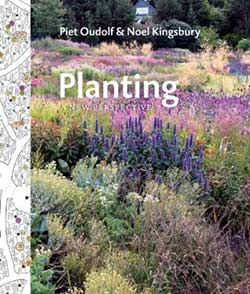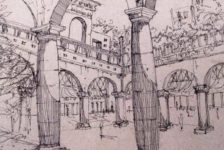Planting: A New Perspective, Piet Oudolf and Dr. Noel Kingsbury The famous Dutch garden designer Piet Oudolf and the designer and writer Dr. Noel Kingsbury have created this wonderful and inspiring book, Planting: A New Perspective, which includes a number of breathtaking pictures of Oudolf’s gardens, highly integrated plant schemes, and useful tables and plant charts. The book is easy to follow and intriguing–in exactly the same way Oudolf’s spectacular gardens are. It is essential reading for anyone interested in creating rich gardens that support biodiversity and lure with beauty. Oudolf is famous for his unique artistic skills in garden designing. He covers a wide range of gardens in the book, from private yards to wide public spaces. Among his projects are the High Line in New York, the Lurie Garden in Chicago’s Millennium Park, and his own private garden in Hummelo in the Netherlands.
This book is the fourth successful collaboration by the authors. Kingsbury is internationally known as a writer on plants, gardens, and environments and promotes what is broadly called an ecological or naturalistic approach to planting design. Planting: A New Perspective shows gardeners and professionals how Oudolf’s gardens and landscapes are made. The authors share their deep understanding of plant ecologies, including how to group the wide range of plants that nature provides us, which plants make good neighbors, and how they behave in different situations to create gardens that require little maintenance. Oudolf’s unique combination of long-lasting perennials and woody plants offer a great diversity in texture, color, and shape that inspire human imagination. His gardens not only appeal with beauty, but also with a high level of diversity and openness to dynamic change. Traditionally, gardens are thought to be static, with every plant having its place and organized in straight lines. Contemporary planting design takes that to new levels and seeks to imitate nature. Oudolf’s gardens are dynamic and changing, not only through the different seasons, but over many years. He teaches us how to balance order and disorder and how to manage spontaneity and change. What a paradoxical situation! Pick up the book here! The book also addresses the topic of how we garden sustainably and in partnership with nature. It focuses on how to combine plants to achieve certain functions and at the same time have aesthetically pleasant results. There are sections relating to biodiversity, climate change, and plant resources. Native plants are often a hugely underexploited design resource, but recently this tendency has shifted and their use has increased. Years of experience result in a plant directory at the end of the book. It covers the majority of the plants used by Piet Oudolf. There is a bias to use plants for open and sunny places, but shade lovers are also included. It records vital information about more than 200 plants, including life expectancy, spread, and propensity to self-seed, which makes the book a valuable resource. Pick up the book here! This book offers different perspectives regarding the future development of planting design. It unfolds the progress of how planting design has moved from a sense of absolute control to one of negotiating with nature. The authors introduce the idea that designers come into play to enhance nature. This idea recognizes the importance of visual beauty for people and the fact that artificial ecosystems can support considerable levels of biodiversity. Oudolf’s gardens appeal with beauty, they are calm and full of surprise, seemingly effortless but hard to define and achieve. This book is the perfect solution for anyone seeking to diversify their design and excite clients, inviting them into a world that develops out of a fairy tale. Now, are you ready to get planting? Planting: A New PerspectiveLogin
Lost Password
Register
If this is your first time on the new site, please click "Forgot your password?". Follow the steps to reset your password. It may be the same as your old one.









